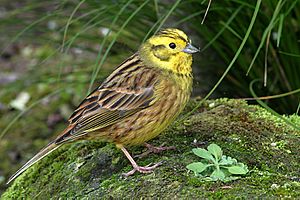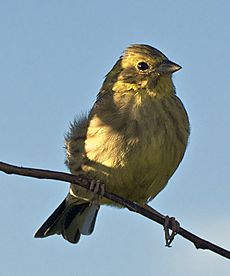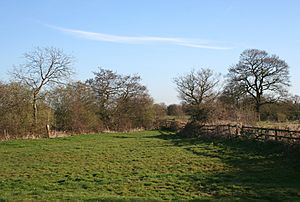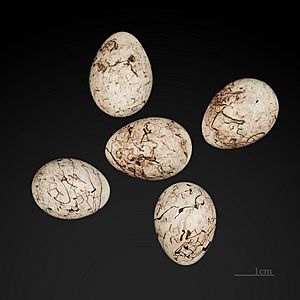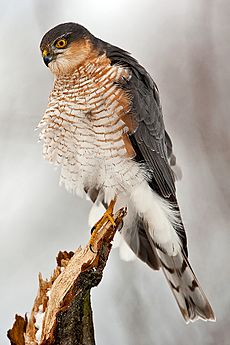Yellowhammer facts for kids
Quick facts for kids Yellowhammer |
|
|---|---|
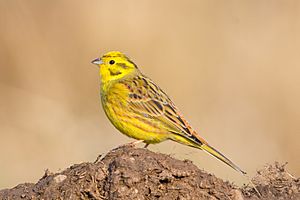 |
|
| Male E. c. citrinella | |
| Conservation status | |
| Scientific classification | |
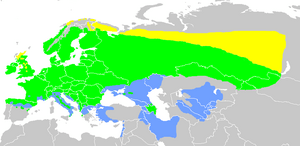 |
|
|
Breeding summer visitor
Approximate natural rangeResident year-round Winter visitor |
The yellowhammer (Emberiza citrinella) is a small bird from the bunting family. It lives naturally in Europe and Asia. This bird has also been brought to New Zealand and Australia.
Most yellowhammers in Europe stay in the same area all year. However, some from the eastern parts of their range travel south for winter. Male yellowhammers are easy to spot with their bright yellow heads, brown backs, and yellow undersides. Females and young birds have similar but duller colors.
Yellowhammers like open areas with some bushes or trees. In winter, they often gather in small groups. Their song sounds like "A little bit of bread and no cheese." This song is very similar to that of their close relative, the pine bunting. Sometimes, these two types of birds even breed together.
Yellowhammers usually start breeding in April or May. The female builds a cup-shaped nest on or near the ground. She hides it well. The eggs have fine dark lines, which is why people used to call them "scribble larks." The female sits on the eggs for about 12 to 14 days. Once hatched, the baby birds stay in the nest for 11 to 13 days. Both parents feed the chicks. Yellowhammers can have two or three groups of babies each year.
Their nests can be raided by small animals or crows. Adult yellowhammers can be hunted by birds of prey. Yellowhammers mostly eat seeds from the ground, especially in winter. During breeding season, they also eat insects. Sadly, changes in farming have caused their numbers to drop in western Europe. But because there are still so many of them across a huge area, they are listed as a species of least concern by the IUCN.
This bright yellow bird has inspired many artists. Poets like Robert Burns and John Clare wrote about it. Its song even influenced music by Beethoven and Messiaen. The children's author Enid Blyton helped make its song famous as "A little bit of bread and no cheese."
Contents
Yellowhammer Family Tree
The bird family called Emberizidae includes about 300 types of birds that eat seeds. Most of these live in the Americas. However, the Emberiza group, which has over 40 members, is only found in the Old World (Europe, Asia, Africa).
The yellowhammer is most closely related to the pine bunting. They are so similar that some people have thought they were the same species. The white-capped bunting and cirl bunting are also close relatives. Where yellowhammers and pine buntings live near each other, they sometimes breed together. The yellowhammer is usually stronger in these mixed pairs.
Carl Linnaeus first described the yellowhammer in 1758. He gave it the scientific name Emberiza citrinella. The name Emberiza comes from an old German word for a bunting. Citrinella is Italian for a small yellow bird. The English name "yellowhammer" likely comes from another German word, Ammer, which also means bunting.
Types of Yellowhammers
There are three main types (subspecies) of yellowhammers:
- E. c. citrinella: This type lives in southeast England and most of Europe. It stretches east to parts of Russia and Ukraine.
- E. c. caliginosa: This type is found in Ireland, the Isle of Man, and Great Britain (except southeast England).
- E. c. erythrogenys: This type breeds from Russia and Ukraine east to Siberia and Mongolia. It also has smaller groups near the Black Sea and in the Caucasus.
What Yellowhammers Look Like
The yellowhammer is a fairly large bunting. It is about 16 to 16.5 centimeters (6.3 to 6.5 inches) long. Its wingspan is about 23 to 29.5 centimeters (9 to 11.6 inches). It weighs between 20 and 36.5 grams (0.7 to 1.3 ounces).
The male E. c. citrinella has a bright yellow head. Its back is brown with streaks, and its rump (lower back) is reddish-brown. Its belly is yellow, and its outer tail feathers are white. The female is not as brightly colored. She has more streaks on her head, chest, and sides. Both sexes look less bright outside of breeding season. This is because dark edges on their new feathers hide some of the yellow. Young birds are much duller and less yellow than adults.
After breeding, adult yellowhammers replace all their feathers. This takes at least eight weeks. Males get more yellow feathers each time they molt. Young birds replace some of their feathers soon after they learn to fly.
The differences between the subspecies are small and change gradually across their range. For example, the male E. c. caliginosa is a bit smaller and darker than the main type. It also has more streaks on its back and a greenish tint on its head. The male E. c. erythrogenys from the east is paler and has fewer streaks.
It can be hard to tell females of the three subspecies apart just by their feathers. Females and young yellowhammers, especially the pale eastern type, might be confused with pine buntings. However, yellowhammers always have some yellow color, a paler reddish-brown rump, and more even upper parts. Young and female yellowhammers can be told apart from cirl buntings because cirl buntings have a grey-brown rump.
Yellowhammer Sounds
The male yellowhammer's song is a series of short notes that get louder. It ends with one or two longer notes. People often describe it as "A little bit of bread and no cheese." This song is almost the same as the pine bunting's song. If the last notes are missing, it might sound like a cirl bunting.
Other sounds include a "zit" call for contact and a "see" sound for alarm. They also make a trilled "tirrr" sound when flying.
Male yellowhammers learn their songs from their fathers. Over time, different areas have developed slightly different song endings. But birds from different areas still understand each other's songs. Each male has his own set of song variations. Females tend to choose males that share their song style and have more song variations.
Pine buntings and yellowhammers are so closely related that they react to each other's songs. The male yellowhammer's song is more attractive to females. This helps explain why yellowhammers are more common where their ranges overlap.
Where Yellowhammers Live
Yellowhammers breed across Europe and Asia. They are the most common and widespread bunting in Europe. However, they do not live in high mountains, very cold Arctic areas, or most of Spain, Greece, and the western Netherlands. They breed east into Russia and Ukraine. Their Asian range extends into Turkey, the Caucasus, and Kazakhstan.
Most European yellowhammers stay in their breeding areas during winter. Only birds from the far north move south. Some travel up to 500 kilometers (310 miles) to warmer places like Spain and Italy. Asian yellowhammers travel more. They leave the northern areas to spend winter in Iraq, Iran, and southern Central Asia. Yellowhammers have also been seen by chance in places like the United Arab Emirates and the Himalayas.
Yellowhammers from Britain and Ireland were brought to New Zealand in 1862. They quickly spread across the main islands. They sometimes visit New Zealand's subantarctic islands but rarely breed there. They have also reached Australia's Lord Howe Island. In the early 1900s, this bird was seen as a serious farm pest in New Zealand. Yellowhammers have also been introduced to the Falkland Islands and South Africa.
The yellowhammer likes dry, open areas. It prefers places with different types of plants and some trees for singing. They do not live in cities, thick forests, or wetlands. They probably first lived at the edges of forests and in large clearings. They have done well with traditional farming, which created open areas with hedges and groups of trees.
Yellowhammer Life and Habits
Reproduction and Nesting
Breeding usually begins in early May, but sometimes in April in warmer southern areas. Yellowhammers usually have one partner and start breeding when they are one year old. Males claim territories along hedges or forest edges. They sing from a tree or bush, often until July or August. The male shows off to the female by raising his wings and running towards her.
The female builds the nest on or near the ground. It is usually well hidden in tall grass, against a bank, or low in a bush. She uses plant materials like leaves, dry grass, and stalks. The inside is lined with fine grasses and sometimes animal hair. The nest is about 11.5 to 13 centimeters (4.5 to 5.1 inches) wide. The cup part is about 4 to 4.5 centimeters (1.6 to 1.8 inches) deep.
A group of eggs, called a clutch, usually has three to five whitish eggs. They often have a pattern of fine, dark lines. Each egg is about 21 x 16 millimeters (0.8 x 0.6 inches) and weighs about 2.9 grams (0.1 ounces). The female sits on the eggs for 12 to 14 days until they hatch. She then keeps the tiny, downy chicks warm until they leave the nest 11 to 13 days later. Both parents feed the chicks. Yellowhammers can raise two or three groups of babies each year.
About 54% of adult yellowhammers in the UK survive each year. For young birds, about 53% survive their first year. Yellowhammers usually live for about three years. However, some have lived for more than 13 years in Great Britain and Germany.
What Yellowhammers Eat
Yellowhammers mostly find their food on the ground. Their diet is mainly seeds. They prefer starchy seeds over oily ones. They eat seeds from plants like common nettle, docks, common knotgrass, and fat hen. Grasses are also important, especially cereals like wheat and oats. Grain makes up a lot of their food in autumn and winter. When they are not breeding, yellowhammers feed in groups. These groups can sometimes have hundreds of birds. They often mix with other buntings and finches.
During the breeding season, yellowhammers add invertebrates (like insects) to their diet. This is especially important for feeding their growing chicks. They eat many different kinds of insects, including springtails, grasshoppers, flies, beetles, caterpillars, earthworms, and snails. For the first few days, chicks are only fed insects. But after about three days, they also start eating cereal grains. This helps the young birds get used to eating seeds.
Dangers to Yellowhammers
Birds that hunt yellowhammers include the sparrowhawk, northern goshawk, and hobby. The common cuckoo does not often lay its eggs in yellowhammer nests. However, because yellowhammers nest on the ground, their eggs and chicks can be eaten by small mammals like mice and other rodents. Nests are also raided by crows, Eurasian jays, and Eurasian magpies. In a 2012 study in Germany, predators caused more than 60% of nest failures.
Yellowhammers can also have fleas and internal parasites. They might carry blood parasites. Males with many parasites tend to have fewer offspring. They also tend to be less brightly colored. This suggests that the male's bright feathers might show how healthy he is for breeding. Yellowhammers with certain blood parasites might not survive as well in winter because their wings can be shorter.
Yellowhammer Status
The International Union for Conservation of Nature (IUCN) estimates that there are between 54 and 93 million yellowhammers in Europe. This suggests a total of 73 to 186 million birds in Europe and Asia. Even though their numbers seem to be going down, the decrease is not fast enough to make them a threatened species. Because there are so many yellowhammers and they live across a huge area (about 12.9 million square kilometers or 5 million square miles), the IUCN lists them as a species of least concern.
In recent years, yellowhammer numbers have dropped in western Europe, including the British Isles, Belgium, and Italy. The yellowhammer is on the red list (meaning its numbers are severely declining) in Ireland and the UK. In eastern Europe, their numbers seem stable. Changes in farming methods are thought to be the reason for fewer breeding yellowhammers. The yellowhammer population brought to New Zealand has been very successful. They have many more birds there than in the UK.
Yellowhammers in Culture

The yellowhammer is a noticeable and vocal bird that used to be very common. Because of this, people have been interested in it for a long time. Places like Yellowham Wood and Yellowham Hill in England are named after the bird. The poem "The Yellow, Yellow Yorlin'" by Robbie Burns gets its title from a Scottish name for the yellowhammer.
John Clare wrote two poems about the bird, "The Yellowhammer's Nest" and "The Yellowhammer." The last lines of "The Yellowhammer" say:
In early spring, when winds blow chilly cold,
The yellowhammer, trailing grass, will come
To fix a place and choose an early home,
With yellow breast and head of solid gold.
Children's author Enid Blyton helped make the bird's song famous as "little bit of bread and no cheese" in her books. She also wrote a poem called "The Yellow-hammer."
Some people believe that Beethoven got the idea for the first four notes of his 5th symphony from the yellowhammer's call. However, it was more likely the opening of his 4th Piano Concerto. Beethoven also used the yellowhammer theme in two of his piano sonatas, numbers 21 and 23.
The composer Olivier Messiaen often found inspiration in birdsong for his music. The yellowhammer's song appears in several of his works, including Chronochromie and Catalogue d'oiseaux.
An old story says that the yellowhammer's tongue had a drop of the devil's blood. The patterns on its eggs were also thought to hide a secret, possibly evil, message. These dark ideas sometimes led people to harm the bird. The unusual look of the eggs also led to the old name "scribble lark."
See also
 In Spanish: Escribano cerillo para niños
In Spanish: Escribano cerillo para niños



